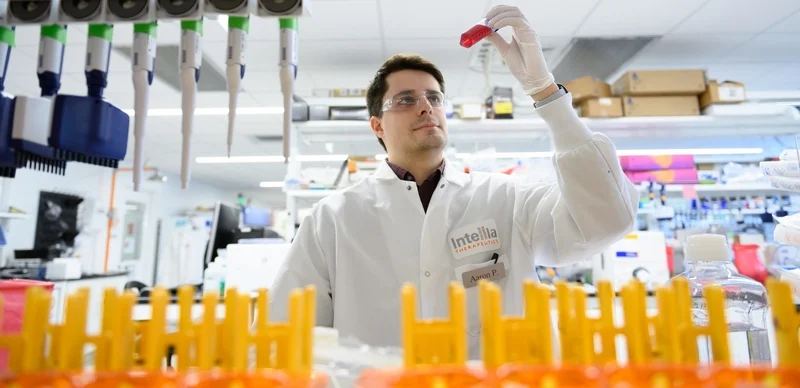Intellia has always wanted its gene editing therapy NTLA-2001 to be trialed in all types of the rare disease transthyretin (ATTR) amyloidosis. Now, the CRISPR/Cas9 genome editor has accelerated those plans by slipping cardiomyopathy patients into an existing early-stage study.
“We believe we will generate key data in the patient population faster,” CEO John Leonard, M.D., said during a presentation at the J.P. Morgan Healthcare Conference Wednesday.
ATTR amyloidosis is a rare and fatal disease that occurs in people born with TTR gene mutations, which cause the liver to produce abnormal, often misfolded TTR proteins. The damaged proteins, which in a healthy form help carry thyroid hormone and vitamin A in the blood, build up in the body, causing a host of problems to the nervous system, heart and other organs.
Intellia and partner Regeneron made waves in June when the biotech reported the first gene editing results from a human trial. The data showed that the therapy reduced levels of transthyretin, a key biomarker for the disease, by 87%, besting standard-of-care therapies that have reached 80%.
The biotech began by testing its gene editing therapy in the polyneuropathy subtype of the disease, which shows up as nerve damage. But rolling out access across the different types of the disease has always been in the cards.
Intellia’s Chief Medical Officer David Lebwohl, M.D., spoke to a recent setback from fellow ATTR amyloidosis treatment maker BridgeBio, which reported a “baffling” result in a phase 3 trial at the end of December. The biotech’s therapy, acoramidis, failed to beat placebo on the study’s main goal, which was a six-minute walk test.
Asked how those results might inform Intellia’s future trial design, Lebwohl said the two treatments are completely different. BridgeBio is trying to stabilize levels of transthyretin, while NTLA-2001 reduces it.
“We know already from other types of amyloidosis that reducing protein has a very major effect on benefit to patients and that’s really ultimately the important factor,” Lebwohl said.
However, Lebwohl acknowledged that the information collected in BridgeBio’s study—as well as a similar one expected soon from rival Alnylam—will inform what Intellia does in its advanced trials. Intellia may consider alternate endpoints instead of the six-minute walk test, such as death or cardiovascular events.
“We do feel good, in some ways, that we’re getting information from other trials … that will help us design the best trial in the coming months,” Lebwohl said.
The question that’s been following Intellia since initial NTLA-2001 data came out is, when will we hear more? Turns out, the answer is soon—very soon. Leonard promised interim results from the phase 1 study later this quarter.
Intellia is enrolling the polyneuropathy portion of the trial as well as those cardiomyopathy patients this year.
Collecting data on all types of ATTR amyloidosis is going to be important for NTLA-2001’s future. The drug will be launching into a market that already has approved treatments for the cardiomyopathy indication in Ionis’ Tegsedi and Pfizer’s Vyndaqel.
Elsewhere in Intellia’s pipeline, interim data from NTLA 2002, which is being tested in hereditary angioedema, is expected in the second half of the year. The company also plans to select multiple new development candidates this year to advance and will share updates on its R&D and platform technologies throughout the year, according to Leonard.
Intellia presented at JPM shortly after peer Editas Medicine made its pitch to investors. Editas was the second company to report first-in-human gene editing results, but the company took some flak for releasing extremely limited data. Investors will certainly be watching Intellia and Editas for their dueling data drops throughout the year.

